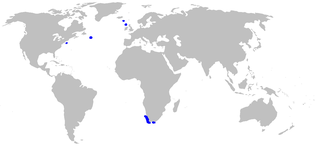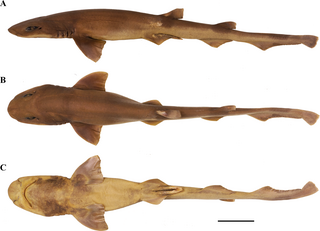
Catsharks are ground sharks of the family Scyliorhinidae. They are the largest family of sharks with around 160 species placed in 17 genera. Although they are generally known as catsharks, some species can also be called dogfish due to previous naming. However, a dogfish may generally be distinguished from a catshark as catsharks lay eggs while dogfish have live young. Like most bottom feeders, catsharks feed on benthic invertebrates and smaller fish. They are not harmful to humans. The family is paraphyletic, containing several distinct lineages that do not form a monophyletic group.
The New Zealand catshark is a catshark of the family Scyliorhinidae in the order Carcharhiniformes. This species is endemic to in the deep waters around New Zealand. Its length is up to 45 centimetres (18 in). The New Zealand catshark is a small, little-known deep water bottom shark. It is dark brown around the top with a few widely spaced pale spots, and white below. It feeds on bottom-living crustaceans. It is also completely harmless to humans.

The African ribbontail catshark, Eridacnis sinuans, is a finback catshark of the family Proscylliidae, found in the western Indian Ocean, from Tanzania, South Africa, and Mozambique, at depths between 180 and 480 m. It can grow up to a length of 37 cm.
The Arabian catshark is a catshark of the family Scyliorhinidae. It can grow up to 30 centimetres (12 in) long, and lives in open seas. It is only known from a single specimen, now lost, which was found on the continental slope of the Arabian Sea.

The lined catshark or banded catshark is a species of catshark, belonging to the family Scyliorhinidae. It is found in the waters off the coasts of Beira, Mozambique, to East London, and South Africa between latitudes 19°S and 31°S, from the surface to 290 m. It can grow up to 56 cm in length.

The spotless catshark is a catshark of the family Scyliorhinidae found in the South China Sea at depths between 535 and 1,020 m on the continental slope. Its length is up to 71 centimetres (28 in).

The bristly catshark is a cat shark of the family Scyliorhinidae, found from southeastern India and the Andaman Islands, between latitudes 15° N and 5° N, at depths between 200 and 300 m. Its length usually ranges from around 20–26 cm, and it is regarded as the smallest catshark of Bythaelurus.
The dusky catshark is a catshark of the family Scyliorhinidae that is endemic to the southeast Pacific Ocean, off the coasts of Peru and Chile. It grows to a maximum length of 70 cm, and is oviparous like many other chondrichthyans in the Indo-Pacific.

The blackspotted catshark is a catshark of the family Scyliorhinidae. It is found in the waters off the coasts of Japan, Korea, China, and Taiwan between latitudes 39° N and 20° N, at the depths of between 80 and 100 m. It can grow up to 49 cm in length.

The Saldanha catshark is a species of catshark, belonging to the family Scyliorhinidae. This catshark is found from Cape Columbine to south of False Bay in South Africa, between 31 and 40°S. Its length is up to 88 cm. It is a plain, dark grey-brown, stout catshark, with moderately large eyes, a broad snout, and large pectoral fins.

The smalleye catshark is a catshark of the family Scyliorhinidae, found in the southeast Atlantic at depths between 700 and 2,000 m. It can grow up to 61 cm. The reproduction of this catshark is oviparous.
Bythaelurus is a genus of deep-water catsharks and part of the family Scyliorhinidae. The genus Bythaelurus Compagno 1988 was first described as a subgenus of Halaelurus Gill 1862 based on several morphological characteristics including a soft body with thin skin, a bluntly rounded snout without a pointed, knob-like tip, and eyes not noticeably elevated on the dorsal surface of the head. Members of this genus are generally found in deep water and have more somber body coloration.
The mud catshark or brown catshark is a species of catshark in the family Scyliorhinidae. It is found in Mozambique and Somalia. Its natural habitat is the open seas of the western Indian Ocean, from Mozambique to Somalia, between latitudes 13° N and 29° S, at depths between 340 and 765 m. It can grow up to 34 centimetres (13 in) long.
The sombre catshark is a species of catshark in the family Scyliorhinidae. It is known from a single specimen south of Rote Island, northwestern Australia. Its natural habitat is the open seas.
The jaguar catshark, also known as the Galápagos catshark, is a species of catshark from the Galápagos Islands. The species was first described in 2012. This catshark is about a foot long when mature, and it is colored blackish-brown with an asymmetrical pattern of light spots.
The dusky snout catshark is a catshark of the family Scyliorhinidae. This species is found from the Southwest Indian Ridge, southwestern Indian Ocean. The specimens were collected from 89–1,443 m depth in both bottom trawls and midwater trawls. The shallowest catch record of the new species, possibly at 89 m, came from a midwater trawl. This species can be distinguished from its two closest congeners, B. giddingsi and B. lutarius, by a combination of prominent comb-like dermal denticles along the upper caudal-fin margin, absence of oral papillae, uniform body coloration, and noticeable dark dusky snout; Bythaelurus giddingsi has oral papillae present and a variegated color pattern, while B. lutarius lacks a caudal crest of enlarged denticles and matures at a much smaller size than the new species.
The narrowhead catshark is a catshark of the family Scyliorhinidae. This species is described based on one adult and one juvenile male specimen from off Tanzania and Mozambique in the western Indian Ocean. The species differs from its congeners by its slender head and snout, which is only slightly bell-shaped in dorsoventral view without distinct lateral indention. It further differs from B. clevai by attaining a smaller maximum size and having a color pattern of fewer and smaller blotches, larger oral papillae, a shorter snout, and broader claspers without knob-like apex and with a smaller envelope and a subtriangular exorhipidion. Compared to B. hispidus, the species has a longer snout, a longer dorsal-caudal space, broader clasper without knob-like apex, and fewer vertebral centra. In contrast to B. lutarius, B. tenuicephalus attains a smaller size and has a blotched coloration, numerous oral papillae, shorter anterior nasal flaps, a longer caudal fin, a shorter pelvic anal space, and shorter and broader claspers.

Bythaelurus stewarti, the Error Seamount catshark, is a catshark of the family Scyliorhinidae in the order Carchariniformes. It is endemic to Error Seamount, a guyot located in the Arabian Sea in the western Indian Ocean. Its closest relative is the bristly catshark, which it differs from in its larger size, darker and more mottled coloration, and especially its smaller and less densely concentrated denticles.
Bythaelurus vivaldii, Vivaldi's catshark, is a species of catshark found in Northwestern Indian Ocean, specifically in Somalia. It presumably lives in the depths of up to 628 m (2,060 ft).











